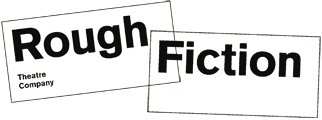Reviews – Hospitals and Other Buildings That Catch Fire
This show was produced at Edinburgh Festival 2005, The National Student Drama Festival 2006, and also revived by the Brit School in 2009 at The Croydon Clock Tower. Read more about it here.
Metro, Friday, August 26th, 2005
Drawn To The Fire
****
As elliptical, strange and modern as the title might suggest, this production by InForm Theatre Company is a highly recommended slice of Fringe drama.
Written by Phil King … this piece fuses together diverse elements into a surprisingly coherent whole. Take some Radiohead-style alienation, mix it with some Douglas Coupland flights of postmodernist fancy, then present the whole shebang with the deconstructive flair of The Wooster Group playing Pirandello and you’ll start to get some idea of what’s in store.
Presented by a cast of four women and two men, the show is deliberately informal. Audience members are given name tags and invited to chat to the performers so that the fourth wall is not so much breached as forcibly demolished.
Some of the comic asides could easily detract from the sober subject of Hospitals, which deals with a couple struggling with their daughter’s illness, but somehow the relief helps you focus on their emotional plight.
The meaning isn’t always clear but when the presentation is this innovative, that’s hardly a problem. King’s play demands repeat viewings and a text is available from the Underbelly box office, so book your brain in for a full check-up for this incendiary hospital appointment.
Eddie Harrison
The Scotsman, 16th August, 2005
No escape from Life’s questions. InForm Theatre push the boundaries of text and performance.
****
YOU have the feeling something unusual is going on here from the moment you arrive. Members of the cast are handing out name tags to the audience and a woman who says she is a nurse is offering massages, and cooing words of welcome, as she shows people to their seats. There is something over-solicitous about her concern, though, that puts you on edge rather than reassuring you. The boundaries of the stage are already being eroded. Playing with the limits of text and the dynamics of performance is an integral part of this piece written by Phil King … Actors share parts and disagree about how roles should be played. Two or three of the cast, or even all of them, will start chiming in with the script while performing awkward balletic movements in unison. It is as if the performers are trying to escape from the script and wrestle themselves away from the stage. I kept thinking of Picasso’s Les Demoiselles d’Avignon, in which three painted women seem to be trying to tear themselves from the canvas. Director Simon Pittman pushes these young actors to their physical and emotional limits, and the writing also makes the audience work hard, making us strain for narrative among the fractured fragments of the script. Nothing makes complete sense until the closing moments, but the themes of the piece are more important than any kind of linear story. At the emotional heart of it is a portrait of grief showing the way sickness, death and loss can scatter the human consciousness. The concrete buildings of the city where the action is set are like a secondary character that encloses the hearts of the people trapped within. I kept remembering a phrase an Indian wise woman said to me earlier this year: “Human beings have become so fragile. This is not the way human beings are meant to be.”
British Theatre Guide, 9th August 2005
Hospitals And Other Buildings That Catch Fire
**** (*)
Hours after leaving this haunting production, the melancholic hope inspired by Hospitals and Other Buildings that Catch Fire will remain with the audience. This is a painfully sweet and nostalgic work, examining tragedy and love in a modern city setting. The plot is a touch convoluted, with the intention (as stated in the programme, which also contains a copy of the script) being for audience members to follow the journey of Tom and Katie, a couple with a desperately ill child. The wounds borne by the two parents are reflected in a number of stories the company tells the audience as they lead their viewers through the struggles of characters who drift in and out of the city’s spheres. What could be a bleak and depressing experience is transformed into a modern-day fairy tale, despite the difficult and dark subjects handled. This is due in no small part to the actors’ efforts to involve and acknowledge the audience, drawing us gently into writer Phil King’s world. Under the direction of Simon Pittman, the entire cast, particularly Annabelle Morgan, infuse the production with warmth and care from the moment the doors are opened. Upon examination of the script, it’s clear that there is a spirit of genuine creativity and generosity suffusing Hospitals. It begins with the script but is also evident in the physical and puppeteering work done by the company. The various forms of theatre used in this production highlight and support King’s lyrical text. This allows audience to become involved in the piece without feeling threatened, as one often can when forced to perform in a theatrical piece, and makes Hospitals one of the warmest pieces of theatre I’ve seen so far at the 2005 Fringe.
